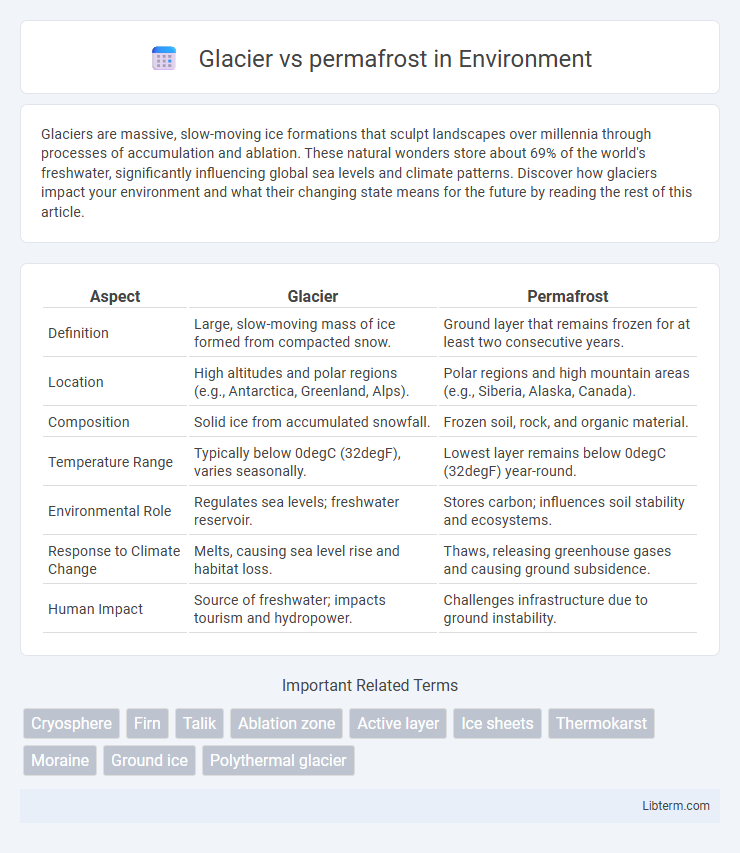Glaciers are massive, slow-moving ice formations that sculpt landscapes over millennia through processes of accumulation and ablation. These natural wonders store about 69% of the world's freshwater, significantly influencing global sea levels and climate patterns. Discover how glaciers impact your environment and what their changing state means for the future by reading the rest of this article.
Table of Comparison
| Aspect | Glacier | Permafrost |
|---|---|---|
| Definition | Large, slow-moving mass of ice formed from compacted snow. | Ground layer that remains frozen for at least two consecutive years. |
| Location | High altitudes and polar regions (e.g., Antarctica, Greenland, Alps). | Polar regions and high mountain areas (e.g., Siberia, Alaska, Canada). |
| Composition | Solid ice from accumulated snowfall. | Frozen soil, rock, and organic material. |
| Temperature Range | Typically below 0degC (32degF), varies seasonally. | Lowest layer remains below 0degC (32degF) year-round. |
| Environmental Role | Regulates sea levels; freshwater reservoir. | Stores carbon; influences soil stability and ecosystems. |
| Response to Climate Change | Melts, causing sea level rise and habitat loss. | Thaws, releasing greenhouse gases and causing ground subsidence. |
| Human Impact | Source of freshwater; impacts tourism and hydropower. | Challenges infrastructure due to ground instability. |
Introduction to Glaciers and Permafrost
Glaciers are large, persistent masses of ice formed from compacted snow that slowly deform and flow due to gravity, primarily found in polar regions and high-altitude mountains. Permafrost refers to ground--soil or rock--that remains frozen for at least two consecutive years, typically located in Arctic and sub-Arctic zones. Both glaciers and permafrost play critical roles in Earth's cryosphere by influencing climate regulation, water storage, and ecosystem stability.
Defining Glaciers: Formation and Composition
Glaciers form through the accumulation and compaction of snow over extended periods, transforming into dense ice masses primarily composed of recrystallized snow. These slow-moving bodies of ice develop in regions where annual snowfall exceeds melting, such as polar and high-altitude environments. Unlike permafrost, which consists of permanently frozen soil or sediment, glaciers are dynamic ice formations actively shaping landscapes through erosion and deposition.
What Is Permafrost? Key Characteristics
Permafrost is ground that remains continuously frozen for at least two consecutive years, primarily found in polar regions and high mountain areas. It consists of soil, rock, and organic material, often containing significant amounts of ice that influence ground stability and local ecosystems. Key characteristics include its thermal sensitivity, slow thawing process, and its role in storing vast amounts of trapped carbon dioxide and methane, which can impact global climate change when released.
Geographic Distribution: Where Glaciers and Permafrost Occur
Glaciers are predominantly found in high mountain ranges such as the Himalayas, Rockies, and Andes, as well as polar regions like Antarctica and Greenland. Permafrost occurs extensively in the Arctic tundra, covering large parts of Alaska, Siberia, and Northern Canada, and can extend into subarctic and alpine areas. The geographic distribution of glaciers is closely tied to elevation and latitude, whereas permafrost presence is primarily controlled by sustained low temperatures in soil and rock.
Differences in Structure and Formation
Glaciers are massive, slow-moving ice bodies formed from compacted snow over centuries, characterized by dense, crystalline ice layers that flow under their own weight. Permafrost consists of permanently frozen ground, including soil, rocks, and organic material, formed from the long-term freezing of subsurface layers rather than surface accumulation of snow. While glaciers exhibit dynamic movement and reshaping due to melting and refreezing cycles, permafrost remains largely stable, though it can thaw gradually due to climate change.
Climate Influence on Glaciers versus Permafrost
Glaciers respond to climate variations through melting and ice mass loss, significantly influenced by temperature increases and altered precipitation patterns. Permafrost is highly sensitive to rising air temperatures, which lead to thawing and subsequent ground instability impacting ecosystems and infrastructure. Both glaciers and permafrost serve as critical indicators of climate change, reflecting distinct but interconnected cryospheric responses to global warming.
Effects of Melting: Environmental Impacts
Melting glaciers contribute to rising sea levels, which threaten coastal ecosystems and increase the frequency of flooding. Thawing permafrost releases significant amounts of methane, a potent greenhouse gas that accelerates global warming and disrupts local habitats. Both processes destabilize landscapes, leading to soil erosion, loss of biodiversity, and altered water cycles that impact regional climates.
Role in Earth's Ecosystems
Glaciers act as freshwater reservoirs, releasing meltwater that supports river ecosystems and influences global sea levels. Permafrost stores vast amounts of organic carbon, regulating greenhouse gas emissions and affecting climate feedback loops in Arctic and subarctic environments. Both glaciers and permafrost play crucial roles in maintaining biodiversity and stabilizing Earth's climate systems.
Human Activities and Their Impact
Human activities such as industrial development, mining, and infrastructure expansion accelerate glacier retreat and permafrost degradation by increasing greenhouse gas emissions and surface disturbance. Accelerated thawing of permafrost releases stored carbon dioxide and methane, intensifying global warming and destabilizing ecosystems and built infrastructure. Glacier loss reduces freshwater availability for millions, impacting agriculture, hydropower, and drinking water supplies in alpine and polar regions.
Future Trends: Glaciers and Permafrost in a Changing Climate
Rising global temperatures accelerate glacier melt and permafrost thaw, releasing significant amounts of stored carbon dioxide and methane, which exacerbate climate change. Remote sensing and climate models predict continued glacier retreat and deeper permafrost degradation, threatening coastal ecosystems and infrastructure stability in Arctic regions. Emerging research emphasizes the need for enhanced monitoring of glacial mass balance and permafrost thermal dynamics to inform climate adaptation strategies.
Glacier Infographic

 libterm.com
libterm.com